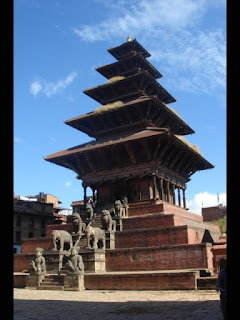If you're thinking about getting to Kathmandu from Bihar (one of India's poorest states, and recently flooded to all heck), don't. The bus from Bodhgaya to Patna was ok. I found my way to the right station in Patna at about 9pm, ten minutes before the last bus for the border town of Raxaul left. Weaving my way through the buses, almost there, leaving India, the only white face.
"Hello, hello!" Damn, spotted.
He came over to me, eyes shining. "What is your name? Where are you from?" Another one of these conversations. After giving my details, including my job and how much I earn, I begged (literally) my leave.
"Please, spend time, this is special for me". Special for him but one of 100 conversations I could have like this every day. A quick
chalo, a dissapointed Indian, and I'm on the bus. Twenty curious, funny and happy Nepali faces stare at me from the back, loaded with all their possessions. These are boys going back home after working in hotels and restaurants in India. They make room for me in the very back of the bus and the chattering starts again.
These guys were cute, friendly, ferocious and kinda small (but stocky). They reminded me of Ewoks (the Nepali Gurkha's won 13 VC's in battles I imagine as similar to the Battle for Endor's Moon). It was noticeable that the four Indians on the bus were the assholes. Two got into a fight over their seats (the Nepali heads all popped up to watch), the guy next to me had the corner seat but refused to move over more than an inch, and the driver was a speed-demon who didn't believe in slowing down for potholes.
Since the road to Raxaul is basically 12 hours of continuous pothole intespersed with bits of road, this meant everyone in the back occasionally flew up and slammed our heads into the roof. I had a spring sticking into my arse from the chair. Even with our shirts off we were drenched with sweat. I went from thinking to hoping I was about to die, to hoping I was. I'm not trawling for sympathy here, I just narrate in my head in bad situations. I got to Raxaul, one last baksheesh for the customs official to say goodbye to India, and it was a rickshaw ride into Nepal. I felt like Hemingway making it to Switzerland in A Farewell To Arms.
The customs guy. I had to wake him up:

Towards the border by cycle rickshaw: I had to hunt for the office to get a visa - the border is open with India. No one in Nepal has checked it since.

Across the border, things were immediately more relaxed. Nepal customs consisted of a few guys in a little bungalow, chatting. There were a few new hand gestures to decipher. People looked like they were from all the ethnicities of Asia - Polynesian, Chinese, Indian, Afghani. The Terai is the lowest and most fertile part of Nepal, and since malaria was eradicated recently it's been populated by different people from the hills, looking to make a living. Ethnic Indians who speak and identify as Nepali make up a large part of the original population of the Terai.
The landscape was the same as it had been for miles and miles since
Bodhgaya - flat green rice fields. A few weeks later the Koshi river burst it's banks and flooded the whole area.
I got on a bus heading for Kathmandu, thinking I'll catch up on some sleep from my 16 hour journey on the way. Ahahahaha. There was a strike on the main road, so we decided to take the little-used (except, perhaps, by extreme motorcyclists) village roads. If the bus from Patna was a sweat box, this was a sauna on Mars. Half way through the Terai we were stopped at a village by a queue of buses and trucks. Village strike. With the Maoist recently in power people in Nepal have gone strike happy. We couldn't go back or forwards. Strikes in Nepal are much more calm and relaxed than they would be in India though - one guy complained that the villagers weren't offering enough food for those blocked in. I sympathised - it's hard to get good food at a strike these days. We eventually started moving and I fell asleep, looking forward to Kathmandu.
Four hours later I was back in Birganj, the Nepal side of Raxaul. The Lonely Planet accurately describes it as "unlovely".
Here's a storm front coming in:

A few minutes later, the road was a dustbowl:

I got a bus the next day, heading up the beautiful Tribhuvan Highway:


























 Giant hands:
Giant hands:























